Convenience of location is a major consideration for consumers in coffee chain market research
In the face of such fierce competition in the coffee industry, and the mentality of constant hype and consumption in the pursuit of popularity in the media, many new brands continue to move in, and at the same time drive the popularity of the new culture, while the differences between brands are becoming smaller and smaller. how to build their own style in such a competitive market is necessary, so this group adopts the method of case study to conduct in-depth interviews with seven coffee chains. Explore the marketing combination strategy adopted by the industry in this market, and develop six propositions as follows: 1. At present, the selection and positioning of the target customer group of the chain coffee industry is not clear, so that there is no differentiated marketing strategy; 2. For those who are located in the chain coffee industry with medium and high prices, their products are mainly coffee, supplemented by meals; for those who are inexpensive, they are mainly meals, supplemented by coffee. The lower the price of the chain coffee shop, the more it will affect the choice of location, and then the slower the speed of the exhibition shop. Coffee shop chains mainly adopt different industry alliances to increase advertising efficiency, but less use of television advertising; 5. American-style coffee chains mainly sell coffee coupons to improve the return rate of customers, while Japanese-style coffee chains mainly offer feedback gratitude days. The consumer loyalty of chain coffee is not high, and the convenience of location is the main consideration of consumers.
The first chapter is introduction
The first section is the research background and motivation
The mysterious and quiet image of the cafe of the personality shop is like a place for lovers to rendezvous, and it is usually expensive, the products are few features, and there are light meals in the store, not exclusive cafes. However, with the improvement of people's spending power, coffee drinks are becoming more and more popular, and the number of Chinese coffee drinkers has also increased. Japanese-style and Italian-style coffee chains have begun to appear on the streets, such as Rodolene Coffee, Dante Coffee and so on. These stores use 35 yuan of coffee to drive the coffee consumption population of the Chinese people, so that the next wave of American and Italian coffee chains, such as Brista Coffee, Starbucks Coffee and IS Coffee, can develop smoothly in China with the demand of medium and high prices of 100 yuan to 160 yuan, officially pushing the atmosphere of drinking coffee to a peak, and the competition in the coffee chain industry has also entered a white-hot.
Coffee not only promotes the popularity of the new culture, but also promotes the status of the leisure catering industry. From the perspective of coffee chains on the streets, the differences between brands are becoming smaller and smaller, and consumers are more likely to be confused, so this group is on the rise to study how chain coffee shops build their own style in such a competitive market. and the motivation to study the marketing strategy of the chain coffee shop.
Section II Research problems
(1) to understand the marketing strategies currently adopted by various coffee shops
(2) coping strategies in the face of fierce market competition
Section III purpose of the study
(1) to provide a reference basis for newly joining the chain coffee industry.
(2) to provide the future development direction of the chain coffee industry that has entered the Taiwan market.
(3) put forward the research direction to be verified for reference for follow-up study.
Section IV Research restrictions
(1) due to the consideration of manpower, financial resources, time and time cost and the willingness of the interviewees to cooperate, it is impossible to conduct staff visits to all coffee chains.
(2) this study is mainly based on personnel interviews, supplemented by data collection and reference, so in the process of analysis, it may be affected by the interviewees' personal expression ability and thinking mode, and the correctness and objectivity of secondary data have yet to be confirmed.
(3) the coffee chain companies interviewed still have reservations about the provision of information, which will affect the completeness and accuracy of the analysis and writing of the case.
Chapter II case selection and Research methods
Section 1 methods of data collection
I. the choice of research methods
This study is based on seven representative chain stores in China, such as Starbucks, Yishi, Seattle, Guest Xikang, Zhenpan, Rodolun and Dante. The purpose of the study is to explore the current marketing strategies adopted by chain coffee shops, what are the similarities and differences, and how the seven coffee shops use marketing strategies to gain advantages in the industry, as well as their future development. At present, the coffee shop chain can be said to be in the warring States period, and the competition is very fierce. Therefore, this study adopts the research method of actual in-depth interviews with case companies, visits seven chain coffee shops at present, and sums up the actual marketing strategies of seven chain coffee shops through the results of the interview.
In addition, in the case study, this study chooses the service industry marketing combination 7p as the discussion aspect.
II. Procedures for the study
The procedure of this study can be divided into five stages. the first stage is that after our group is interested in the chain coffee shop, in the second stage, we decide to find out the relevant materials and literature for the industry in order to understand the situation of the industry. The third stage is to draw up relevant questions according to the literature studied by this group and the understanding of the current chain coffee industry, and look for suitable people to conduct interviews. In the fourth stage, after the interview, the results are analyzed and compared according to the actual situation of each company and the data collected. Then develop the proposition according to the results of the analysis. Finally, the paper puts forward some conclusions and suggestions on this study, hoping that this study can be helpful to the current market operators and entrepreneurs who want to join the coffee industry.
Section 2 selection of case companies
In the selection of case companies, the main object of this study is the domestic chain coffee shops, and choose the companies with a more representative market share. According to the satisfaction survey of coffee chains conducted by Circulation Express magazine, the most frequently visited coffee chain found that the highest price was 31%, Starbucks 29%, real pot 21%, Seattle 19%. The parity is 41% for Dante, 34% for Lodorum, 17% for Yee and 8% for coffee people. According to the above survey, considering the number of their respective stores when cooperating with the selection, this study not only takes into account the number of stores and popularity, but also takes into account each other's background in this coffee industry. as far as the real pot and customer Xikang who first entered the market are concerned, the real pot has the same door, and the real pot has the brand equity, while the customer Xikang still has the largest number of stores. Yishi and Seattle are self-created brands, and both have bakeries at the same time; Starbucks' brand awareness is taken for granted; Rodollen is the first to introduce 35 yuan cheap coffee; and Danti has the second largest number of stores in the parity price. Each of the seven stores has its own style and background, and they have similarities with each other.
Table 1 object and date of visit to seven chain coffee shops
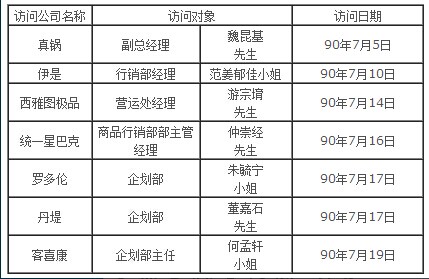
Section III Framework of case interview
In the course of visiting seven coffee shops, we hope to understand how these seven coffee shops use their marketing strategies to achieve competitive advantage for themselves. Therefore, according to the research questions of this study, we draw up the above interview outline:
1. What is the share of the company? The number of existing stores [including direct operation and franchise]?
two。 What are the types of customers? What is the proportion? Main target customers? Why did you come to the store?
3. What impression does the company want to give consumers?
4. What is the sales status of the company's products? What are the main products? Will it be diversified in the future?
5. Pricing method?
6. Site development and selection? The strategy of the exhibition store?
7. What are the company's current promotional activities? Will you want to change in the future? What is the advertising strategy?
8. How does the company manage the franchise store? How do employees choose? What is the ratio of part-time to full-time? What are their advantages and disadvantages? What kind of training and motivation and career planning are provided?
9. Store and in-store design? Purchase of equipment?
10. The source of coffee beans? What are the considerations of your choice? Relationship with coffee bean suppliers?
11. The company's main competitor at present? What are the competitive advantages?
twelve。 What are the key success factors of the company?
13. What is the company's business philosophy and corporate image?
14. Does the company import information system?
15. Is there any alliance between different industries at present? How to choose the object and the way of cooperation?
16. Short -, medium-and long-term goals for the future?
The establishment of the proposition in the first chapter
Proposition 1: at present, the selection and positioning of the target customer group of the chain coffee industry is not clear, so that there is no differentiated marketing strategy.
I. explanation
Market segmentation and then choosing the target market is the core of modern marketing strategy. The wise choice of the target market will help the company to concentrate its resources on the specific target market in a more efficient and efficient way, so that customers can get the best satisfaction. Among the seven coffee chains interviewed in this study, the selected target customers are shown in Table 4.
Table 2 list of target customers of chain coffee industry

From Table 2, it is found that most of the seven chains target office workers between the ages of 25 and 45 as their main customer groups. the current coffee shop chain system can be divided into Japanese (such as real pot), European and American (such as Starbucks) and self-created brands (such as IS COFFEE). According to the price distinction, it can be divided into parity (such as Lodorum) and medium-to-high price (such as Seattle). According to its system and price positioning, the target customers that each operator should attract should be different. however, various operators seem to focus on the similarities of consumers rather than differences, which leads to similar marketing strategies in an attempt to attract the same group of consumers.
II. Interpretation of examples
Through the interview and comparison, it is found that there is no significant difference in the marketing strategies of the seven coffee chains interviewed (as shown in Table 3). Similarly, professional coffee is touted, and the service staff will transfer coffee knowledge in a timely manner. In terms of products, except that a few people insist on not selling Chinese simple meals, the contents of the products sold by various operators are more or less the same. for example, there is a whirlwind of "smoothies" in the market, and new flavors of smoothies have been developed in both high-priced and inexpensive coffee shops. In the way of expansion, they almost all develop from north to south, and most of the shops are concentrated in the north, and the main consideration is the places with large crowds and large traffic flow. in order to effectively reach the crowd, operators also have the ambition to move into department stores, hospitals, MRT stations and science parks.
In order to catch regular customers and stabilize the customer base, operators have launched more preferential ways to attract consumers to buy, such as coffee coupons, coffee passports, membership cards, and so on, and the seven coffee chains are not famous for TV advertisements. but through the alliance of different industries to increase advertising efficiency. In terms of service, except for the Japanese-style real pot and customer Xikang, which boasts full-service dedicated service, they all adopt a semi-self-service mode of service; shops all adopt an open plan and stand outside the door, through clean and bright glass, the condition of the store, it is clear at a glance, "clean, bright, good atmosphere" is the common feature.
Table 3 comparison of marketing strategies of various coffee chains
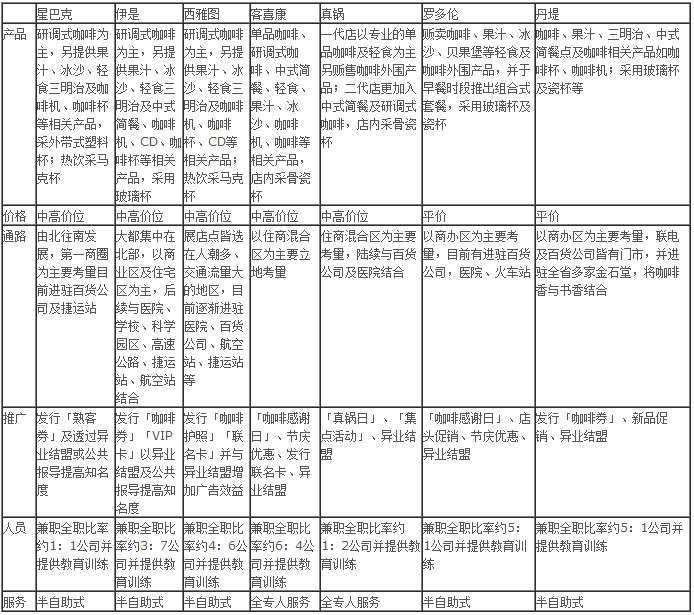
III. Summary
As can be seen from the above description, due to the fierce competition, in order to catch up with consumers, operators continue to bring forth new ideas in commodity research and development, site selection, service quality, promotion methods, environmental comfort and other aspects, but the practices of various companies are similar, so there is not much difference in the minds of consumers, resulting in smaller differences among brands, and consumers are more likely to be confused, which also indicates the importance of brand management. However, in the face of competition from many brands, it is better to expand the market demand and enhance the overall stomach capacity than to break the head.
Proposition 2: for those who are located in the chain coffee industry at medium and high prices, their products are mainly coffee, supplemented by meals, while those in the chain coffee industry at low prices are dominated by meals and supplemented by coffee.
I. explanation
At present, the prices of chain coffee shops are mainly medium-high price and low price, and most of them insist on the provision of meals in order to maintain the quality, with coffee as the main and meal as the auxiliary. It emphasizes the quality of coffee itself and its brand image. For chain operators of parity prices, "setting prices by quantity" and "increasing meals" are the main demands, through which the performance of individual stores can be increased.
II. Interpretation of examples
Table 4 proportion of coffee products to total products
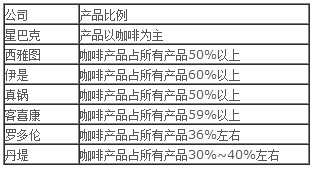
(1) it is hoped that every consumer will smell the strong aroma of coffee as soon as he enters Starbucks. Therefore, apart from cooperating with the sale of self-made light snacks, Starbucks insists on not selling other meals that will confuse the aroma of coffee. Both Seattle and Yi have set up their own coffee roasting plants in order to effectively control the quality of coffee. At the same time, Kexikang and the real pot emphasize to carry forward the coffee path culture, constantly innovate and improve the product structure and coffee quality, hoping that the customers who like mellow taste can enjoy good coffee that is really considerate to consumers.
(2) Starbucks, Seattle, Yishi, Kexikang, and Shinpan have all set up folding booklets in their stores to promote the understanding of coffee, with the aim of educating consumers to have the ability to identify coffee, and then develop a habit of tasting coffee.
(3) although it is restricted by the Japanese contract on Chinese food, Luo Doren still makes a variety of matching meals on other meals, such as a special breakfast, which accounts for more than 1/4 of the total turnover. The provision of three meals in Dandi brings great convenience to consumers, and in order to cater to the living habits of Chinese rice food, the operation of the three meals also provides a variety of Chinese meals for consumers to choose from, and constantly push through the old and bring forth the new.
III. Summary
After all, coffee is not a necessity in Taiwan, so for low-price coffee chains, it is not easy to rely on low-priced coffee to support a shop at a high cost, so it is necessary to strengthen the combination of meals and increase the turnaround rate of the storefront. to increase sales. In addition to emphasizing the economic value brought by the brand and insisting on quality, the chain operators of medium and high-priced coffee should make more efforts to highlight their own brand characteristics among many brands and educate consumers to regard coffee as a part of life. is the goal of the main effort, with Starbucks, Seattle, Yishi, real pot, customer Xikang and other five high-priced coffee chains have published some brochures The purpose of putting it in the store for consumers to obtain is to educate consumers on the ability to recognize coffee.
Proposition 3: the lower the price of a chain coffee shop, the more it will affect the choice of location, and then the slower the speed of the exhibition shop.
I. explanation
Any successful chain system must be able to achieve the economic scale of the number of stores, that is, there must be enough stores in order to give full play to the economic benefits of the chain. In recent years, in Taiwan's important metropolitan area, chain coffee shops have been set up one by one, and chain coffee shops have to be eye-catching, so the choice of location is very important, and the location of chain coffee shops is mainly based on the office circle. The site conditions are mainly based on convenient transportation, and the choice of the site is related to the positioning of their own coffee shops. from the point of view of Xikang and Luo Duolun, the two coffee chains that first entered the Taiwan market, the customer Xikang demanded a high price. However, Luo Doran has a 35-yuan coffee parity strategy, both of which were introduced by Japan, but he entered Taiwan a little earlier, but the current number of 32 stores However, it is not as good as the number of 81 stores in Kexi Kang, and why the number of brand exhibition stores is faster after development. The reason is that the speed of exhibition stores is different due to the difference in price.
Among the seven chain coffee shops interviewed in this study, the distribution and selection of stores in each county and city mainly set up areas, as shown in the following table:
Table 5 the distribution table of the main established areas of each county and city
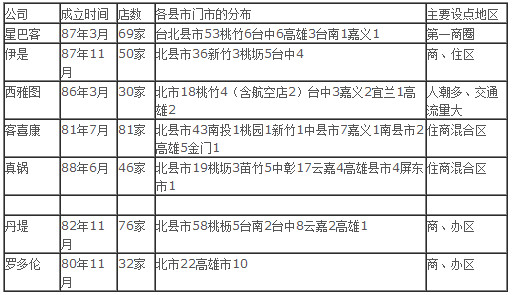
II. Interpretation of examples
(1) Luo Doran was the first to introduce foreign brands, and it was also the first to introduce 35 yuan of coffee to Taiwan, so that the average single price is lower, and the consumption amount is less than 100 yuan, so it is necessary to increase one's own turnover, that is, the number of visitors is more, and the number of visitors is large, so it is very important to make a choice. In order to choose the business area, the flow of people in front of the store must be more than 10,000 person-times a day. Just imagine, the flow of people in front of a store should be more than 10,000 person-times. Of course, the location of this kind of business area is not easy to find. Absolutely must be the prime location of the first business district and must be opened on the side of the road, the alley is absolutely not allowed, but also because such a location is difficult to find, it is not easy to pass the evaluation criteria of the business circle. Of course, it is slow to open a fast shop.
(2) when it comes to real pot cafes and guest Xikang cafes with high prices, due to the higher unit price, the turnover has to be made like 35 yuan coffee, the number of visitors is not so large, but the number of visitors is relatively small, the requirements for the business circle are naturally not so strict, it has to be in the first-class business area, and other business areas are actually suitable for layout, so it is easier to find suitable business areas. Table 5 shows that real pot and guest Xikang have distribution sites almost all over the province, and some of them are located in remote and suburban areas. According to Wei Kunji, vice president of real pot, the turnover of outlets located in remote and suburban areas is not worse than that in cities.
III. Summary
Looking at Taiwan's environment, the business area suitable for opening coffee shops is already limited, but there are many more chain coffee shops. The lower the conditions required by the business circle, the faster the speed of the shop can be displayed. In other words, the more suitable places to open a shop, the easier it is to open a shop, so whether it is a residential area, a business district, an office area, or a mixed area, as long as it is a crowded place, it is more suitable to open a shop.
Proposition 4: American-style coffee chains mainly sell "coffee coupons" to improve customer return rates, while Japanese-style coffee chains focus on feedback-based "Thanksgiving days."
I. explanation
With the rise of cafes in the market like bamboo shoots after a spring rain, the competition tends to be white-hot, all kinds of promotion techniques emerge as the times require, in an attempt to attract the favor of consumers, in order to catch regular customers and stabilize the customer group. Discount is the most common method used by operators, who often improve the flow of information by means of alliances between different industries, so as to inform consumers of discounts, and the main purpose of discounts is to use low prices as an inducement. attract consumers to train from mobile customers to regular customers.
Table 6 promotional techniques commonly used by coffee chains
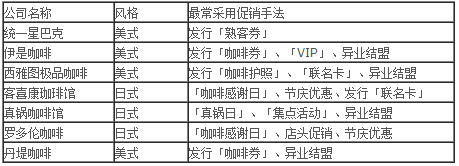
II. Interpretation of examples
(1) Unified Starbucks mainly issues "regular customer coupons". At present, there are ten coffee "familiar customer coupons" issued by Unified Starbucks, each with a price of 900 yuan, each convertible for a medium cup of coffee, and if it is changed to a large cup, it only needs to add 15 yuan. In addition, there is a coupon, as long as the consumer brings his own cup, you can buy coffee with a stamp and cover 10 cups, and you can exchange a medium cup of coffee. And customers fill in their personal information when buying "coupons" and receive an invitation card before their birthday, inviting them to go back to the store to enjoy free coffee.
(2) since its inception, Seattle Gourmet Coffee has issued a "coffee passport" with a price of NT $900, which is equivalent to NT $1,000 in cash. Except for exchangeable coffee, cakes and coffee beans can be used. A passport has a variety of exchange functions. The appearance of the "coffee passport" is similar to that of the ordinary passport, which is about 10 pages. It contains instructions for use, introduction of coffee beans in the store, and 10% discount coupons for coffee beans. According to the industry, most of the consumers who will buy the "coffee passport" are coffee gluttons and business needs. The turnover of the coffee passport also accounts for 20% to 30% of the total turnover, which is not low.
(3) Kexi Kanga Pavilion was introduced in 1992 and opened the first store ~ Taichung Equal Store on July 26 of the same year. At present, there are more than 80 chain stores in the province. in order to thank you, KOHIKAN Jiajie is scheduled on the 26th of each month, which is a day to thank you for feedback. If you come to the store on that day, you can enjoy super-value discounts; and you can get exquisite gifts prepared by KOHIKAN Jiajie. The discounts are as follows: 1. There is a 10% discount on takeout goods. two。 Half-price discount for coffee refills on the same day. 3. This activity can be used together with gift vouchers.
(d) Dante Coffee issues 10 "Coffee coupons" each at a price of 315 yuan, each of which can be exchanged for a cup of coffee at 35 yuan. It is expected that a stored value card of 1,000 yuan will be launched in September this year to meet the lifestyle of modern plastic money.
III. Summary
To sum up, most American-style coffee chains sell coffee coupons, such as "coffee coupons" and "regular customer coupons", on the basis of "capital". In addition to receiving cash in advance, the most important thing is to increase the rate of customers returning to the store, because consumers who often use coffee coupons represent their loyalty to this coffee shop and gradually develop many regular customers. The new consumers brought in by these regular customers will snowball, so the more regular customers they cultivate, the greater the benefits. According to Table 7, 38.3% of consumers get the information about coffee chains from friends and relatives, which is why American chains actively promote coffee coupons. Japanese-style chains, on the other hand, take feedback activities such as "Thanksgiving Day" as representatives, choose a representative day of each month to launch special offers, and have gifts to give back to the broad masses of consumers.
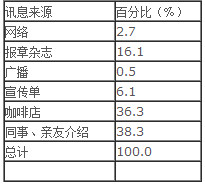
Important Notice :
前街咖啡 FrontStreet Coffee has moved to new addredd:
FrontStreet Coffee Address: 315,Donghua East Road,GuangZhou
Tel:020 38364473
- Prev

Promotion of coffee chain stores to increase advertising efficiency
Coffee shop chains mainly adopt different industry alliances to increase advertising efficiency, but less use of television advertising. First, the combination of explanation and promotion in different industries, such as credit cards or communications operators of banks, can be extended to each other's consumer groups through the resources of the other party, and the other party can stimulate consumers' desire to spend because of the benefits they offer. as a result, consumers can get an extra discount.
- Next

Coffee shop talent management recruitment how to manage coffee shop
In the course of the initial experience of the newly opened coffee shop, we have met people who manage and recruit staff. Here, the teachers of Chongqing Brista Coffee West Point training School give you some initial staff management advice. first of all, the recruitment of staff in the newly opened cafe can be composed of full-time and part-time staff. Full-time staff must find very professional baristas, and then part-time staff will assist in customer service.
Related
- What documents do you need to go through to open a coffee shop? coffee shop coffee shop certificate processing process
- How to purchase Coffee beans in small Cafe how to choose a suitable supplier for domestic Coffee supply Company
- How to drink Starbucks Fragrance White Coffee? how to make Australian White Coffee? what Italian coffee beans are recommended?
- The Story of Flora Coffee: the name of Flora Coffee Bean and the implication of the Flowers on Florna Coffee
- How much does a cup of coffee cost? How much is the profit of a cup of coffee? What is the profit of the coffee shop in a year?
- Yunnan small Coffee, known as "fragrant Coffee", introduces the characteristics of Alpine Arabica Coffee producing areas in Yunnan, China
- 2023 latest Starbucks full menu price list how much is a cup of Starbucks coffee what is better to drink the most popular hot and cold drinks recommended
- Starbucks different kinds of Coffee Price list Starbucks menu 2023 Top Ten Best drinks in Starbucks
- Starbucks Spring praise Comprehensive matching Coffee Bean theme Story Packaging implication and taste description
- The cost of a cup of coffee latte American coffee cost price and selling price

